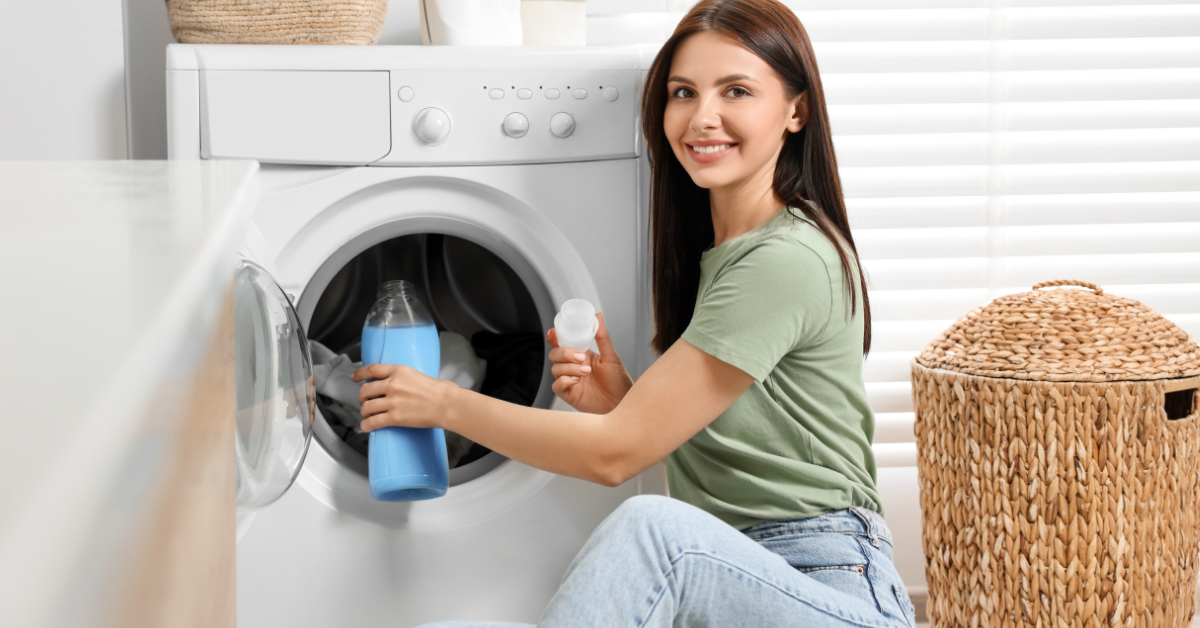Learn how to clean washing machine with this comprehensive guide. Discover step-by-step instructions, natural cleaning solutions, and tips to keep your machine fresh, odor-free, and running efficiently. Washing machines are essential appliances that help keep our clothes clean, fresh, and ready to wear. However, many people neglect to clean the machine itself, which can lead to bad odors, mold, and reduced washing performance.
A clean washing machine ensures that your clothes smell fresh and are free from germs. This article will guide you through all aspects of washing machine maintenance, including the importance of cleaning, signs your machine needs attention, and detailed steps for cleaning both front-load and top-load washers.
Why Cleaning Washing Machine is Essential
Cleaning your washing machine regularly is vital for several reasons. Over time, detergent residue, fabric softener, minerals from hard water, and dirt from clothes can accumulate inside the machine. These substances can:
• Reduce the washing machine’s efficiency, leading to higher energy bills.
• Cause unpleasant odors that may transfer onto your clothes.
• Harbor bacteria, mold, and mildew, which can pose health risks, especially for individuals with allergies or sensitivities.
• Lead to mechanical issues, shortening the life of your appliance.
By maintaining a clean washing machine, you’ll ensure it operates at peak performance, prolong its lifespan, and keep your clothes cleaner and fresher.
Signs Your Washing Machine Needs Cleaning
It’s not always obvious when your washing machine requires a deep clean, but some telltale signs include:
1. Foul Odors: If you detect a musty or sour smell coming from your machine, it’s likely due to mold or bacterial growth.
2. Clothes Not Smelling Fresh: If your clothes still have a stale or unpleasant odor after a wash, it’s a sign that the machine isn’t cleaning properly.
3. Visible Mold or Mildew: You may notice mold growth around the door seal (especially in front-load machines) or in the detergent drawer.
4. Water Drainage Issues: If your washer is slow to drain or there’s leftover water after a cycle, it may be due to a clogged filter.
5. Residue on Clothes: White streaks or powdery residue on clothes after washing indicate that the machine is not rinsing out detergent completely.
6. Excessive Noise: If your machine is making unusual noises during operation, it could be due to clogged parts or detergent buildup.
Tools and Products Needed to Clean Washing Machine
Before you start cleaning your washing machine, gather the following tools and products to ensure you’re fully prepared:
• White vinegar: A natural cleaning agent that helps remove mineral deposits, mold, and bacteria.
• Baking soda: Works as a deodorizer and mild abrasive cleaner.
• Liquid dish soap: A mild detergent for scrubbing surfaces.
• Bleach: For deep cleaning and disinfecting.
• Microfiber cloths or sponges: For wiping down surfaces and cleaning hard-to-reach areas.
• Old toothbrush: Useful for scrubbing mold from seals and detergent dispensers.
• Small bucket: To catch water and debris when cleaning the filter.
• Washing machine cleaner tablets (optional): These store-bought products are designed specifically for cleaning washing machines.
How to Clean a Front-Load Washing Machine
Step-by-Step Guide:
Step 1: Clean the Drum
1. Run a hot water cycle: Without adding clothes, start a wash cycle on the hottest water setting.
2. Add vinegar and baking soda: Pour 2 cups of white vinegar directly into the drum. Once the cycle is halfway through, pause the machine and add 1/4 cup of baking soda. Let the cycle finish.
3. Wipe the drum: After the cycle, wipe down the inside of the drum with a microfiber cloth to remove any remaining grime or residue.
Step 2: Clean the Door Seal
1. Inspect the seal: Pull back the rubber door seal and look for mold, mildew, or trapped debris.
2. Scrub with vinegar: Mix equal parts water and vinegar, then use a toothbrush to scrub any mold or dirt. Wipe dry with a cloth.
Step 3: Clean the Detergent Drawer
1. Remove the drawer: Pull out the detergent drawer and separate any removable compartments.
2. Soak in hot water: Let the drawer soak in warm, soapy water for 10–15 minutes, then scrub with a brush to remove detergent buildup.
3. Wipe down the compartment: Use a cloth to clean inside the detergent drawer slot, ensuring no residue remains.
Step 4: Clean the Filter
1. The filter: Usually filter is located at the bottom front of the machine.
2. Remove and clean: Unscrew the filter cap, remove any trapped debris, and rinse the filter under warm water.
3. Replace the filter: After cleaning, secure the filter back in place.
How to Clean a Top-Load Washing Machine
Step-by-Step Guide:
Step 1: Clean the Drum
1. Start a hot water cycle: Set the machine to its largest load size and the hottest water setting.
2. Add vinegar and baking soda: Pour 4 cups of white vinegar into the water and let the machine agitate for a minute. Pause the cycle and let the mixture sit for one hour to break down soap scum and mineral deposits. After an hour, add 1 cup of baking soda and resume the cycle.
3. Wipe down the drum: Once the cycle is complete, use a clean cloth to wipe down the drum’s interior.
Step 2: Clean the Lid and Exterior
1. Wipe the lid: Use a vinegar solution to clean the lid and control panel.
2. Clean the detergent dispenser: Remove and soak the detergent dispenser in warm, soapy water, then scrub away any residue.
3. Wipe the exterior: Use a damp cloth to clean the machine’s exterior, focusing on corners where dirt may accumulate.
Step 3: Clean the Filter
1. Locate and remove the filter: Like front-load washers, top-load machines also have a filter that traps debris.
2. Rinse and clean: Wash the filter under running water to remove trapped dirt.
How to Clean Specific Parts of the Washing Machine
Detergent Drawer
The detergent drawer often becomes clogged with soap residue and mildew. To clean:
1. At first remove the drawer and then soak it in hot, soapy water.
2. Use a small brush to scrub away residue, paying attention to small crevices.
3. Wipe down the compartment where the drawer sits to remove any grime.
Drum
Over time, the drum can accumulate detergent residue, dirt, and hard water stains. The vinegar and baking soda method mentioned above works well to clean the drum.
Door Seal (for Front-Load Machines)
The door seal in front-load washers can easily trap water, leading to mold. Regularly check and wipe down the seal with a vinegar solution, and ensure it’s dry after every use.
Filter
Washing machine filters can become clogged with lint, debris, and even small items like coins. Locate your filter and clean it regularly to prevent blockages and improve drainage.
Using Natural Cleaners vs. Store-Bought Products
Both natural and store-bought cleaners are effective for cleaning washing machines. Here’s how they compare:
Natural Cleaners:
• Vinegar: An acidic liquid that dissolves mineral buildup, kills bacteria, and eliminates odors.
• Baking Soda: A mild abrasive that neutralizes odors and helps scrub away grime.
• Hydrogen Peroxide: A disinfectant that can kill mold and bacteria without the harshness of bleach.
Store-Bought Cleaners:
• Washing machine cleaner tablets: Designed to dissolve inside the machine and remove odors, mildew, and detergent buildup.
• Bleach: A powerful disinfectant that kills bacteria, mold, and mildew but should be used sparingly to avoid damaging rubber parts.
Natural cleaners are eco-friendly, affordable, and readily available. Store-bought products may offer more convenience but are often harsher on machine parts.
Preventive Measures to Keep Your Washing Machine Clean
Preventive care is key to keeping your washing machine in optimal condition. Here are some tips:
1. Leave the door open after use: This allows air to circulate and prevents moisture buildup, reducing mold growth.
2. Wipe the door seal: After every wash, dry the door seal to prevent mold from forming.
3. Use the right amount of detergent: Excessive detergent can lead to residue buildup. Follow the manufacturer’s guidelines for the correct detergent dosage.
4. Run regular cleaning cycles: Once a month, run a hot water cycle with vinegar or a machine cleaner to keep your washer fresh.
5. Avoid overloading: Overloading your machine can strain its parts and reduce efficiency.
How Often Should You Clean Washing Machine?
How often you clean your washing machine depends on its usage. For light use (1–2 loads per week), a deep clean every 2–3 months should suffice. If you use your machine heavily (3+ loads per week), aim for a monthly deep clean. Regular maintenance, such as wiping the drum and cleaning the door seal, should be done after each wash.
Frequently Asked Questions (FAQs)
Q1: Can I use bleach to clean my washing machine?
Yes, bleach is effective at killing bacteria and mold. However, it should be used sparingly to avoid damaging the rubber seals in your machine.
Q2: How do I get rid of the musty smell in my washing machine?
The musty smell is usually caused by mold or bacteria. Run a hot water cycle with 2 cups of white vinegar and 1/4 cup of baking soda to eliminate odors.
Q3: Is vinegar safe for all washing machines?
Yes, white vinegar is safe for both front-load and top-load machines. It effectively breaks down mineral deposits and cleans without damaging your appliance.
Q4: How do I prevent soap scum buildup in my washing machine?
Overuse of soap can cause buildup. Running regular cleaning cycles with vinegar or a store-bought cleaner can help prevent this issue.
Conclusion
Cleaning your washing machine may not be the most exciting chore, but it’s essential to maintain its efficiency and ensure your clothes remain clean and fresh. Regular maintenance, such as wiping down the drum, cleaning the filter, and using the right amount of detergent, will prolong your machine’s life and improve its performance. With the steps outlined in this guide, you can keep your washing machine in top condition and prevent common issues like bad odors, mold growth, and mechanical problems.
By dedicating a little time each month to cleaning, you’ll ensure your washing machine continues to work effectively, providing you with clean and fresh laundry for years to come.



